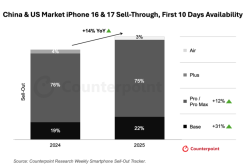Lei Jun and Zhou Yunjie Discuss Rise of "Made in China" on First "Representative Channel"
![]() 03/07 2025
03/07 2025
![]() 408
408

Original by Digital Economy Studio
Author | Uncle You
WeChat ID | yds_sh
On the morning of March 5, the inaugural "Representative Channel" of the Third Session of the 14th National People's Congress was launched. Lei Jun, founder, chairman, and CEO of Xiaomi Group, and Zhou Yunjie, chairman and CEO of Haier Group, jointly appeared to delve into the rise and overseas expansion of "Made in China." The government work report released that day also illuminated the path for future industrial development.

Manufacturing stands as the bedrock of a nation, with technological innovation continually breaking through bottlenecks.
"Five years ago, we resolved to intensify our efforts and further invest in core technologies. Five years have passed, and we have invested approximately 105 billion yuan. This substantial R&D investment has profoundly transformed Xiaomi." Lei Jun elaborated that as a newcomer in the automotive sector, Xiaomi delivered over 135,000 vehicles in just nine months last year. "We dare to compete with the world's strongest rivals. On the Nürburgring track in Germany, the prototype of Xiaomi SU7 Ultra recorded a lap time of 6 minutes and 46.874 seconds, making it the fastest 4-door car in the track's history. These achievements are inextricably linked to technological innovation."
"Manufacturing is the cornerstone of our nation and the foundation for becoming a powerful nation," Lei Jun emphasized. Manufacturing is the lifeblood of China's economy, evolving from "Made in China" to "Intelligent Made in China," and from "the world's factory" to "global innovation." The pulse of China's manufacturing industry beats at an astonishing pace.
We can personally feel that the great changes unseen in a century are accelerating in today's world, with profound adjustments in global industrial and supply chains, intensifying competition among major powers, and developed countries advancing "reindustrialization." Emerging economies are vigorously undertaking international industrial transfers leveraging their cost advantages. A few Western countries have continuously escalated their suppression and sanctions against China's advanced manufacturing industry, attempting to curb the development of China's high-tech and strategic emerging industries.
Simultaneously, a new round of technological revolution and industrial transformation is progressing in depth. Modern technologies, represented by artificial intelligence, big data, cloud computing, quantum information, as well as new materials, new energy, and biomedicine, are advancing rapidly, accelerating the integration of technological innovations across disciplines, industries, and fields. In this context, only by strengthening technological innovation can we achieve breakthroughs in the manufacturing industry.
The robot dancing the yangko dance during this year's Spring Festival Gala has drawn the public's close attention to this emerging industry, representing the development direction of China's manufacturing industry. After a decade of rapid development, China's robotics industry has achieved a tremendous leap from small to large, entering a new stage of high-quality development, becoming better and stronger, and emerging as a significant force in the global robotics industry.
China has been the world's largest market for industrial robots for 11 consecutive years, with the new installed capacity accounting for over 50% of the global market in the past three years. Industrial robots are applied in 71 major industries of the national economy, making robots a quintessential representative of China's important high-end equipment and new productive forces for advancing new industrialization. Behind this lies technological innovation and independent research and development.
For instance, the vacuum manipulator is a crucial device responsible for wafer transport between different stations in the chip manufacturing process. The repeated positioning accuracy requirement in advanced process manufacturing reaches 0.02mm. This equipment has long been monopolized by foreign enterprises, constituting a genuine "bottleneck" technology. Siasun independently overcame the technology of the new generation of vacuum manipulators and achieved mass application in China's most advanced chip manufacturing factories, providing safe, efficient, and reliable automation solutions for the semiconductor industry.

Seventy percent of global household appliance patents originate from China, with impressive overseas performance.
"For an enterprise to go global, it must anchor the foundation of technological innovation, constantly seeking and excelling to truly become top-notch," Zhou Yunjie said on the Representative Channel. He gave an example: At the 2014 IEC International Electrotechnical Commission Annual Meeting, when Haier first proposed an international standard for refrigerator freshness, it faced opposition from many countries' representatives, with the argument that it was impossible for a Chinese enterprise to set an international standard from scratch. However, currently, Haier has led or participated in the issuance of 111 international standards, spearheading the technological innovation of global household appliances. China has also become a leader in global household appliance innovation, with seven out of every ten global household appliance patents now originating from China. This underscores that technological innovation is a pivotal variable for a brand to establish itself in the world.
The success of Haier Group is merely a microcosm of China's household appliances accelerating their entry into the global market. In 2024, China's household appliance exports delivered impressive results: the overall export volume of household appliances increased by 20.8%. Among them, air conditioner exports surged by 28.3% year-on-year, refrigerator exports rose by 19.7% year-on-year, and washing machine exports increased by 14.2% year-on-year. Today, whether in traditional manufacturing or emerging technology fields and internet service industries, many Chinese enterprises are rapidly rising in overseas markets, providing high-quality products and services to global users.
For instance, in the automotive industry, the number of Chinese automotive brands going overseas has soared from 760,000 in 2015 to 6.41 million in 2024 over the past decade. Among them, the total overseas shipments reached 4.91 million in 2023, surpassing Japan for the first time and has now surpassed Japan for two consecutive years, becoming the world's largest automotive exporter. The rise of Chinese automakers no longer relies on low-price competition but wins respect through technology and quality, much like Japanese cars did in the past. Chinese cars are transforming the world's stereotype of Chinese manufacturing.
As an outstanding performer among automakers going overseas, BYD exported 66,300 new energy vehicles in January 2025, surpassing Chery for the first time and topping the list of Chinese automotive exports. This is the inevitable outcome of adhering to technological innovation and intelligent development. Recently, BYD heavily launched the "Universal Intelligent Driving" strategy, bringing high-level intelligent driving capabilities of the Tian Shen Zhi Yan system to models priced at 70,000 yuan, instantly igniting discussions in the field of intelligent driving. Imagine, when your car is no longer a cold piece of steel but has a pair of "sharp eyes" that can automatically recognize road conditions, judge traffic signals, and even navigate complex cities with ease, it feels like a scene from a science fiction movie.

The government work report sets the direction, embarking on the vast sea of stars for future industries.
We must develop new productive forces according to local conditions and accelerate the construction of a modern industrial system. The 2025 government work report released on March 5 outlined the direction for the next development of "Intelligent Made in China" – conducting large-scale application demonstration actions for new technologies, products, and scenarios, and promoting the safe and healthy development of emerging industries such as commercial aerospace and the low-altitude economy. Establish a growth mechanism for investment in future industries and cultivate future industries such as biomanufacturing, quantum technology, embodied intelligence, and 6G.
China's reusable launch vehicle successfully completed its first 10-kilometer vertical take-off and landing flight test; the G60 Qianfan Constellation officially kicked off the prelude to large-scale satellite networking, and China's Star Network's "State Grid Constellation" officially entered the stage of batch networking; the Hainan Commercial Aerospace Launch Site and the Long March 12 rocket both achieved complete success in their respective maiden missions. In 2024 alone, China's commercial aerospace enterprises achieved numerous accomplishments.
Commercial aerospace encompasses the entire process of launch vehicle and satellite manufacturing, launch, as well as communications, navigation, and remote sensing. China's commercial aerospace industry chain is gradually becoming complete, with the capability to produce 100 rockets and 300 satellites annually, driving a domestic aerospace information market exceeding 100 billion yuan while nurturing a plethora of application scenarios. These market-verified "satellite + agriculture," "satellite + emergency response," and "satellite + ecology" models can be directly replicated overseas.
As a representative of future industries, 6G is currently still in the research and development stage, with technology giants rushing to seize core technologies. Apple believes that 6G commercialization can be achieved by mid-2029; Samsung anticipates that 6G standards and small-scale commercial applications will be completed by 2028, with large-scale commercial applications expected by 2030; Huawei, Nokia, and other technology companies have also expressed that 6G commercialization is anticipated by 2030.
It is generally believed that 6G's communication capabilities will be more than 10 times that of 5G. The development from 5G to 6G is a progression from the Internet of Everything to the "Intelligent Internet of Everything and Digital Twins." 6G will drive more immersive holographic video and realize the interconnection of the physical world, the virtual world, and the human world. Additionally, 6G's space-ground integration will realize the true meaning of "base stations in the sky" directly connected to mobile phones. In the future, aspects such as satellite payloads, inter-satellite routing, and satellite-ground core networks will gradually be realized with the maturation of 6G standards, complementing the booming industry trend of domestic and foreign satellite internet industries.

Two-way efforts in technological investment and consumption boost.
Technological innovation is not only a requirement for industrial development but is also closely tied to market consumption.
A vast consumer market has always been a catalyst for science and technology, capable of turning sparks in the laboratory into a prairie fire. Today's China leverages the basic necessities of life for 1.4 billion people, industrial upgrades in 2,000 cities, capital flows of 200 trillion yuan, and the world's most complete and powerful industrial chain to build the largest and most complex innovation ecosystem in human history.
The market not only transforms the innovation achievements of enterprises into commercial profits, making innovation sustainable, but it is also the incubator and testing ground for enterprise innovation. Especially today, when scenarios and data are increasingly becoming innovation factors, the market serves as both the guidance and support for innovation. The decisive factor for China's leading position in the mobile internet field is its huge domestic market, which creates vast and diverse application scenarios as an innovation testing ground and provides advantages such as data samples and user feedback for innovation.
Expanding effective investment, particularly in high-tech industries, new infrastructure, and the green economy, can stimulate effective demand through precise investment, improve supply quality, and thus achieve a benign interaction between supply and demand. This two-way effort will provide robust impetus for stable economic growth.
2025 is the final year of the 14th Five-Year Plan and the planning year for the 15th Five-Year Plan. As we stand at the forefront of new productive forces and look ahead, the globalization of "Made in China" has entered a new era of defining standards. This transformation confirms a simple truth: True globalization is not the extension of geographical boundaries but the reconstruction of value coordinates.
——The End——








